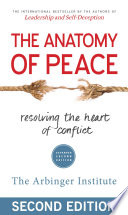

The central premise of 'The Anatomy of Peace' is that true peace begins within the individual rather than external circumstances. The book emphasizes that conflict arises from a 'heart at war' mindset, where individuals view others as obstacles or threats to their needs and desires. This perspective leads to a cycle of blame, resentment, and hostility. To achieve peace, one must shift to a 'heart at peace' mindset, recognizing the humanity in others and understanding that everyone has their own struggles and desires. This internal transformation is crucial for resolving conflicts and fostering harmonious relationships.
Continue readingIdentity plays a significant role in how individuals perceive themselves and others. The book illustrates how a person’s self-concept can lead to conflict when they feel threatened or marginalized. When people define themselves primarily in opposition to others, it creates a battleground mentality. The authors suggest that embracing a more expansive identity that includes empathy and understanding can help dismantle barriers and foster connection. By recognizing shared humanity, individuals can move beyond divisive labels and work towards collaborative solutions.
Continue readingEffective communication is a cornerstone of conflict resolution. 'The Anatomy of Peace' stresses the importance of dialogue in addressing misunderstandings and grievances. The book advocates for open, honest conversations where individuals can express their feelings and perspectives without fear of judgment or retaliation. This kind of dialogue encourages active listening and fosters a deeper understanding of differing viewpoints. By creating a safe space for discussion, parties can begin to bridge divides and work towards mutual understanding and respect.
Continue readingBlame is a destructive force in relationships and conflicts. The book discusses how assigning blame to others not only perpetuates conflict but also prevents individuals from taking responsibility for their own actions and feelings. By shifting the focus from blame to understanding, individuals can break the cycle of conflict. The authors encourage readers to examine their own contributions to disputes and to approach conflicts with a mindset of curiosity rather than accusation. This shift can lead to more constructive outcomes and healthier relationships.
Continue readingForgiveness is portrayed as a transformative act that can liberate individuals from the burdens of resentment and anger. 'The Anatomy of Peace' highlights that holding onto grudges often harms the person who is unwilling to forgive more than the one who has caused harm. The book emphasizes that forgiveness does not mean condoning harmful behavior but rather choosing to let go of the emotional weight associated with it. By embracing forgiveness, individuals can free themselves from the past and open the door to healing and reconciliation.
Continue readingEmpathy is presented as a vital tool for conflict resolution. The authors argue that understanding another person's feelings and perspectives can significantly alter the dynamics of a conflict. By practicing empathy, individuals can step into the shoes of others, which fosters compassion and reduces hostility. The book encourages readers to cultivate empathy in their interactions, suggesting that this practice can lead to more peaceful resolutions and stronger relationships. Empathy not only helps to resolve conflicts but also builds a foundation for future cooperation.
Continue readingThe book concludes with the idea that achieving peace is an ongoing journey rather than a destination. It suggests that individuals must continually work on their mindset, relationships, and communication skills to foster a peaceful environment. The authors encourage readers to embrace the complexities of human interactions and to remain committed to personal growth and understanding. This journey requires patience, practice, and a willingness to confront uncomfortable truths about oneself and others, but it ultimately leads to deeper connections and a more peaceful existence.
Continue reading